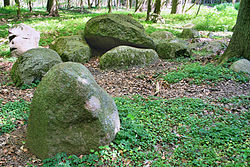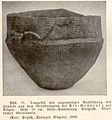Ducal tomb
| Ducal tomb Great stone grave Alt Reddewitz | ||
|---|---|---|
|
The ducal grave in the Mönchgut Forest |
||
|
|
||
| Coordinates | 54 ° 20 '32.5 " N , 13 ° 41' 50" E | |
| place | Mönchgut, Mecklenburg-Western Pomerania , Germany | |
| Emergence | 3500 and 2800 BC Chr. | |
| Sprockhoff no. | 509 | |
The duke's grave is a Neolithic megalithic complex ( large stone grave ) on the Mönchgut peninsula on the island of Rügen in Mecklenburg-Western Pomerania . The large stone grave with the Sprockhoff no. 509 was created between 3500 and 2800 BC. BC in the Neolithic as a megalithic system of the funnel beaker culture (TBK). “Neolithic monuments are an expression of the culture and ideology of Neolithic societies. Their origin and function are considered to be the hallmarks of social development ”.
location
The Großdolmen is located in the Mönchgut nature reserve , which is one of the maintenance zones in the Southeast Rügen Biosphere Reserve . The duke's grave is located on the hiking trail that begins just a few meters northwest of the junction of the B 196 to Middelhagen (800 meters west).
Geologically , the duke's grave is located on the southern edge of the Baaber Heide spit , less than 100 meters from the Littorina-era cliff of the Göhren-Reddevitz ridge. From the former steep coast, which was created 6000 to 7000 years ago by marine erosion , it is very likely that the boulders from which the barn bed with the burial chamber was built around 4000 years ago come from.
In addition to the results of other age determinations, the ducal grave is considered to be evidence that the Baaber Heide spit - at least in this area - existed more than 4000 years ago.
The Baaber Heide was, like other Rügen Heiden , z. B. the Schmale Heide and the Schaabe (formerly Wittower Heide ), were afforested in the middle of the 19th century and are now largely covered by the Mönchgut Forest .
exploration
The teacher and local poet Fritz Worm from Alt Reddevitz, who was interested in local history , had been looking for the ducal grave since 1920 after hearing about a legend. In 1922 he found it on the forest path between Alt Reddevitz and Göhren under bushes and moss. From 1922 to 1924 it was examined in detail for the first time by the prehistorian Franz Klinghardt with the participation of the archaeologist Armin von Gerkan from the University of Greifswald . It turned out that the actual burial chamber is surrounded by an approximately 15 meter long trapezoidal stone setting (barn bed). The tomb has existed since the Neolithic, but had several subsequent burials. It was a cremation grave (urns) but also a body grave (skeletons). About 40 remains of individuals were found that were examined and examined by the anthropologist Theodor Mollison . Numerous, relatively completely preserved urns, as well as a variety of Neolithic tools - stone axes, grinding plates for shotguns, rifles, etc. were recovered. Urns and ceramic shards were from the funnel beaker culture with deep engraving. Jewelry parts - e.g. B. Amber pearls rounded off the range of finds.
In 1960 (according to other sources, 1962), again by the University of Greifswald, the large stone grave was examined again. After the burial chamber was opened, numerous grave goods were found. These included ceramic shards from at least 26 clay vessels, 22 flint axes, two rock axes, three flint chisels, 56 cross-cutting arrowheads and numerous amber beads.
The approximately 5.40 meter long burial chamber is formed on the long sides by four stones, in the north it is closed by a larger stone. The vestibule, which is particularly typical of Rügen's large dolmen and consists of two upright stone slabs, is located on the south side. One capstone with a mass of six tons has been preserved in its original size, two more have broken into several pieces.
During the excavations, the bones of 30 to 40 people were recovered who had been buried here around 4000 years ago, probably over a longer period of time.
The recovered grave goods and the excavation documentation are now part of the archaeological collection of the Ernst Moritz Arndt University of Greifswald.
See also
Web links
literature
- Ralf-Otto Niedermeyer, Heinz Kliewe, Wolfgang Jahnke: The Baltic Sea coast between Boltenhagen and Ahlbeck - a geological and geomorphological overview with excursion tips . 1st edition. Hermann Haack / Geographisch-Kartographische Anstalt, Gotha 1987 (Geographical building blocks, issue 30), ISBN 3-7301-0633-3 , p. 124.
- Ingrid Schmidt: Hünengrab and sacrificial stone: soil monuments on the island of Rügen. Hinstorff Verlag Rostock 2001, ISBN 3-356-00917-6 , pp. 28-29.
- Ernst Sprockhoff : Atlas of the megalithic tombs of Germany. Part 2: Mecklenburg - Brandenburg - Pomerania. Rudolf Habelt Verlag, Bonn 1967, pp. 73-74.
- Fritz Worm : From the prehistoric times of the Mönchgut peninsula. Alt Reddevitz 1928, page 15 ff., New edition as facsimile in May 2006.









